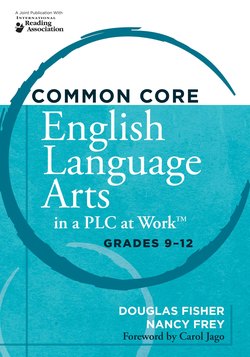Читать книгу Common Core English Language Arts in a PLC at Work®, Grades 9-12 - Nancy Frey - Страница 6
На сайте Литреса книга снята с продажи.
ОглавлениеFOREWORD
In his poem “We Make the Road by Walking,” Antonio Machado explains that our own footsteps make up the road we tread. The path only becomes clear with a backward glance. However, too many schools are in search of the perfect path—the shortest route to the Common Core. Teachers often become frustrated with their lack of progress or when one direction they have taken seems to lead nowhere. They blame themselves, they blame the standards, and they blame the process. Sometimes they even blame the students. Instead of pointing fingers, teachers should read Common Core English Language Arts in a PLC at Work™, Grades 9–12. Douglas Fisher and Nancy Frey demonstrate how collaborative teamwork—and a laser-like focus on student performance—can help schools create their own path to achieving the Common Core.
Teachers who are new to the profession often wish they had worked in the “good old days.” Alas, if thirty-two years in the classroom have taught me anything, it is that there were never good old days. My students have always been challenging, have always been averse to hard work, and have always been wonderful. What has changed is the stakes. More than ever before, students need to acquire high levels of literacy in high school in order to continue learning in postsecondary settings. This need for college and career readiness was the impetus for creating the Common Core State Standards.
The texts students will encounter in college and in job-training programs are highly complex. Students need stamina to negotiate pages of information-laden readings and the syntactical confidence to comprehend what they read. They need to bring a broad range of background knowledge and a robust vocabulary to these readings. They need to be independent readers who know what to do when understanding breaks down. The problem for most high school teachers is that, in their heart of hearts, they believe it is not their job to “fix” students who can’t read. Somebody else along the way has dropped the ball, making his or her job almost impossible. Teachers need to explore this assumption before they can make progress toward helping students meet the Common Core State Standards.
Will aligning curriculum to the Common Core turn our high schools into test-prep factories and our collaborative teams into benchmark assessment generators? Nothing in the Common Core recommends that approach. The standards place a high priority on a rich and rigorous literature curriculum along with a focus on informational texts. The standards also insist that literacy instruction is the shared responsibility of the entire school community, which is difficult to achieve since many content-area teachers already insist they have too much material to cover to spend instructional time focusing on literacy. Teachers need to recognize that reading and writing about different disciplines, such as history and science, deepen students’ understanding of what they are learning. Teachers also need to admit that some classroom practices have pushed students away from literacy rather than toward it. Instead of creating lessons that invite students to dig in and explore a text, many teachers make them answer questions rather than encouraging them to come up with their own. Literacy is an important building block for many other skills.
Such literacy of the standards must be assessed, however. That’s why the Partnership for Assessment of Readiness for College and Careers (PARCC) and the Smarter Balanced Assessment Consortium (SBAC) come in. PARCC and SBAC’s standards-based performance assessments are modeled on authentic, integrated reading and writing tasks. They offer students texts worth reading and tasks that challenge them to analyze the claims writers are making. Usage and mechanics in writing will be measured not with multiple-choice items but through student writing. If the assessment consortia are able to achieve their own lofty goals, these tests will be models for good instruction.
The Common Core anchor standards provide high schools with a clear destination—college and career readiness—and working in collaborative teams, focusing on student performance, and using common assessments are steps in the right direction on the path. If you or your collaborative team members think the Common Core’s outcomes are unrealistic, read them through the lens of a parent. Would you want your child to know and be able to do what is described? Do you want your child challenged by these rigorous expectations? If the answer is yes, as school teachers, we need to want the same goals and to work toward the same goals for all our students. Let Douglas Fisher and Nancy Frey lead the way.
—Carol Jago, Past President, National Council of Teachers of English;
Associate Director, California Reading and Literature Project at UCLA
